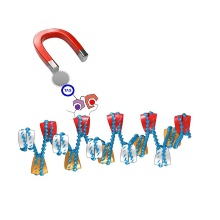New publication in "Epigenetics & Chromatin"
Nucleosomes carry more than 50 different post translational modifications, about 20-30 of them being intensively studied. Therefore, individual nucleosomes can bear complex patterns of different modifications, which could encode diverse functional states, a concept introduced as “histone code” model. In this paper, we introduce a new approach to analyze the genome-wide co-occurrence of two chromatin modifications in a single step ChIP-like experiment. Our strategy uses synthetically fused reading domains to specifically detect doubly modified mononucleosomes. We validate one reagent of this type and show that it specifically binds to mononucleosomes containing H3K9me3 and H3K36me2/3 modifications. Using our engineered double-reading domain, we determined the genome wide distribution of H3K9me3-H3K36me2/3 doubly marked chromatin and show that it occurs in a non-random distribution and represents a novel bivalent chromatin state which is associated with weakly transcribed chromatin and Zinc finger binding sites. We anticipate that this experimental approach will add a new dimension of analysis to the conventional ChIP assay and it will revolutionize the investigation of complex chromatin modifications.
| Contact | Prof. Dr. Albert Jeltsch |
|---|


